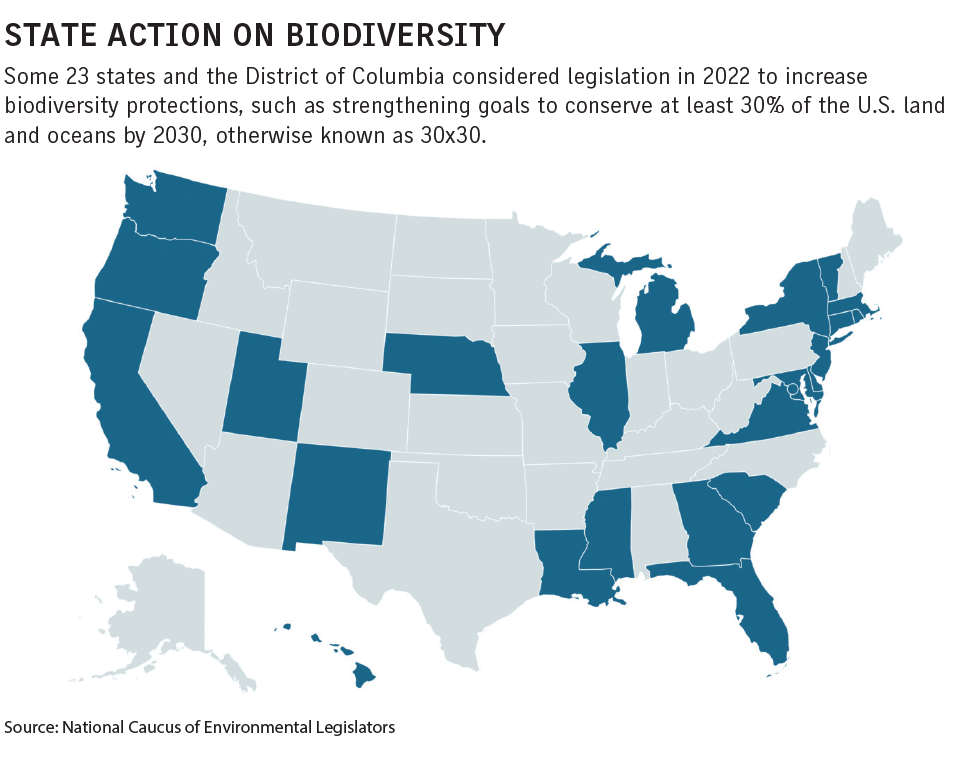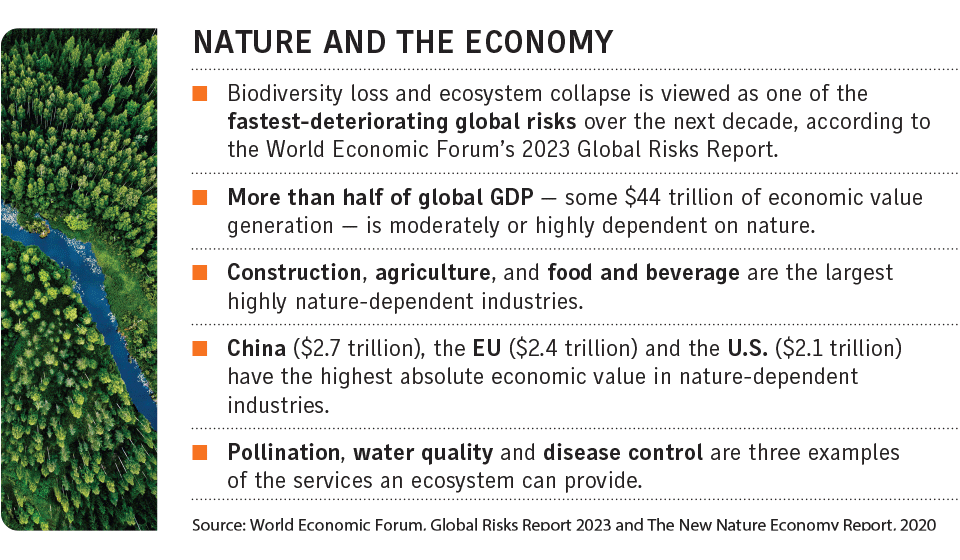Biodiversity risks a growing concern for businesses
Reprints
Environmental, social and governance risks such as climate change and diversity, equity and inclusion have become central concerns for some organizations, but businesses and insurers are also starting to pay closer attention to other ESG-related issues such as biodiversity and nature-related risks as regulatory frameworks evolve.
Development of insurance coverages that can help restore natural ecosystems and protect the businesses and communities that depend on them is in an early stage but likely to grow, experts say.
More sophisticated risk management organizations that lead on managing climate risk tend to be the ones that are starting to think about biodiversity and nature risks and supporting reporting frameworks, said Amy Barnes, London-based head of climate and sustainability strategy at Marsh LLC.
Some industry sectors, such as agriculture, are more exposed than others, Ms. Barnes said. “We then get into food and beverage and further up the supply chain,” and the focus extends far beyond that as well, she said.
But “many clients aren’t really thinking about nature, and it’s not on their immediate horizon of things to map,” she said.
Risk management focus
Momentum is shifting, however.
In September the Taskforce on Nature-related Financial Disclosures, a market-led initiative funded by several governments, the United Nations and philanthropic grants, is expected to release final recommendations for its risk management and disclosure framework that companies can use to report nature-related risks.
Like the Taskforce on Climate-related Financial Disclosures, the TNFD framework could lead to businesses being required to make biodiversity risk disclosures, experts say. The recommendations will be voluntary, but many countries and regulators are mandating climate-risk disclosure in line with the TCFD, and sources say TNFD is likely to take the same trajectory.
ESG standards are having a significant effect on the energy and construction sectors because they are so resource-based and resource-driven, “whether it’s the environmental impact of hydropower projects on rivers, the impact of mining operations around tailings and coal, or oil and gas projects and distribution,” said Darren Tasker, Toronto-based head of energy and construction at Allianz Global Corporate & Specialty SE, a unit of Allianz SE.
Insurers have traditionally been on the back foot when defending their positions on these topics, but now they’re trying to help policyholders operate in as environmentally and socially conscious ways as possible, Mr. Tasker said. Capacity remains challenging, though, for ESG-sensitive projects, he said.
Water is an underappreciated risk, and evolving climate regulations and the development of the TNFD point to growing reputational and regulatory risks in this area, said Suzanne Scatliffe, London-based global sustainability director at Axa XL, a unit of Axa SA.
“The agenda around nature is going to evolve, and we know that a number of sectors are maybe not quite ready for that,” Ms. Scatliffe said.
Many businesses are at the risk identification stage, and that will evolve into risk mitigation and then “how do we more explicitly incentivize and reward clients that are following good water practices,” she said.
Insurers and brokers are navigating uncertain risks and exposures.
For example, Aon PLC is the lead broker for the Klamath River restoration project that involves the removal of four hydroelectric dams to help restore the river’s basin in California and Oregon.
While the insurance coverage was secured before ESG concerns became prominent, there are many social aspects that could be affected by the project, said Matthew Davis, Bend, Oregon-based growth operations leader at Aon.
Various risk scenarios had to be considered, including how the project would affect Native Americans and others in the local community, as well as the potential risk of dam removal, the impact on fish or other habitats, and the risk of wildfire, which is inherent in remote regions of California and Oregon, Mr. Davis said.
Opportunities and risks
Competing risk management priorities and cost concerns remain a challenge to the nascent market for nature-based insurance coverages and services, but policyholder interest is gradually increasing, experts say.
Nature-related risks are more difficult to measure than climate risks in some ways.
“With climate everything can be effectively unitized into carbon or carbon equivalent. Nature is much more complex with many inputs and variables,” Ms. Barnes said.
Insurance policies that protect nature-based systems may carry extra premiums, which few stakeholders are willing to pay, the Geneva Association said in a report issued in November.
Energy efficiency, water conservation, solar installations and the resilience of buildings to withstand climate risks are part of the information risk managers can provide to insurers to demonstrate why they are a better risk, said Scott Ritto, vice president of risk management at Kilroy Realty Corp. in Los Angeles.
“This is a big reason why our loss ratio is 5% or less over the last 10 years,” Mr. Ritto said.
Wes Rimes, Birmingham, Alabama-based vice president and head of sales and distribution at Zurich Resilience Solutions, a unit of Zurich Insurance Group Ltd., said concerns about nearby habitats and waterways have come up in discussions with several large auto manufacturers that were about to build extensions to their facilities and needed help in assessing the impacts.
Many inquiries around biodiversity come from organizations in coastal locations, Mr. Rimes said.
Last month Zurich launched a climate advisory service with South Pole, a carbon finance consultancy based in Zurich. “It’s really about helping businesses understand the other side of the coin and how their operations are impacting the environment, through carbon sequestration, carbon accounting, and helping them develop carbon credit strategies,” he said.
Parametric structures are playing a growing role in policies that pay out when hurricane wind speeds reach a certain level, allowing for repair and restoration of coral reefs, and these types of covers could be extended to other ecosystems such as mangroves, experts say.
“Since parametric insurance pays out based on an understanding of hazard characteristics, it allows us to extend insurance coverage to non-traditional assets like ecosystems such as coral reefs,” said Sarah Conway, head of the ecosystem resilience practice and director in the disaster risk finance and parametrics unit in the climate and resilience hub at Willis Towers Watson PLC, who is based in St-Malo, France.
While these structures typically have been used in emerging economies, they can also be applied in more developed countries, she said.
In November, WTW and the Nature Conservancy announced a coral reef policy in the U.S. The policy, backed by Munich Re, provides Hawaii with up to $2 million in payouts for reef restoration if tropical storm winds reach 57 miles per hour.
Traditional energy, power and gas companies have been “bread-and-butter” buyers of parametric coverages to manage weather volatility and variability in customer demand due to fluctuating temperatures, said Martin Malinow, New York-based founder and CEO of Parameter Climate Inc.
Renewable energy sector demand is also growing, Mr. Malinow said. “We’re seeing a lot more demand for risk transfer products that are indexed to solar irradiance, to wind speed, and to the precipitation or river flow for hydropower,” he said.
Businesses may also be able to tap into existing coverages in the traditional commercial insurance market.
Many specialist environmental insurance policies embraced natural resource damage as a covered event early on, said Bill Pritchard, president of Beacon Hill Associates, a Charlottesville, Virginia-based wholesale broker and program administrator division of Specialty Program Group.
“Environmental policies cover cleanup, and cleanup of a constituent or hazardous material is triggered by the environmental regulation for the presence of that material. Most, but not all, environmental policies define natural resource damages as part of cleanup,” Mr. Pritchard said.
In a hard market, and as ESG risks grow, captive insurers can also help companies manage risks (see related story).
Reputational risk
Activists and investors are increasingly scrutinizing businesses’ operations, how they affect biodiversity loss and could disrupt societies, experts say.
Insurers and brokers, too, face potential reputational risks if they participate in ESG-sensitive agriculture, construction or other projects that disrupt natural habitats and local communities.
Last month a complaint was filed against Marsh LLC by Inclusive Development International, an Asheville, North Carolina-based non-governmental organization, along with various human rights and environmental organizations, alleging the brokerage violated international guidelines for responsible business conduct by serving as insurance broker for the East African Crude Oil Pipeline project.
The complaint alleges improper land acquisition processes, inadequate consultation with affected communities, threats to natural resources and irreversible harm to local ecosystems.
Marsh declined to comment on the complaint, citing its policy of not confirming the identity of clients.
Courts are already considering cases against businesses in relation to liability for biodiversity loss, pointing to increasing legal risk, some attorneys say (see related story).

